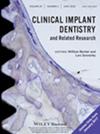Influence of Bone Condition and Implant Design on Accuracy of Semi-Autonomous Robotic Dental Implant Surgery In Vitro
Abstract
Objectives
This study aimed to evaluate the effects of bone density, cortical bone thickness, and implant design on the accuracy of implant placement using a novel semi-autonomous robotic-assisted surgery system (sa-RASS).
Materials and Methods
A total of 160 implants were placed in artificial bone models simulating four bone densities (D1, D2, D3, D4) and three cortical bone thicknesses (0.5, 1, 1.5 mm) using sa-RASS. Two implant designs (self-tapping and non-self-tapping) were evaluated under standardized cortical bone thickness conditions. The postoperative CBCT data and preoperative surgical plan were superimposed to calculate the deviations of the implant. Deviations were quantified for platform/apex positions (global, horizontal, vertical) and implant angulation.
Results
The sa-RASS achieved mean deviations of 0.58 ± 0.19 mm at platform, 0.60 ± 0.24 mm at apex, and 1.46° ± 0.78° for angulation. Bone density significantly influenced accuracy (p < 0.05), with maximum deviations in medium-density (D2/D3) models and minimal errors in high-density (D1) and low-density (D4) groups. Cortical thickness exhibited a moderate positive correlation with linear deviations (platform: r = 0.598; apex: r = 0.593; both p < 0.001). Self-tapping implants demonstrated superior precision compared to non-self-tapping designs (p < 0.05), with reduced deviations at both platform (0.48 ± 0.16 mm) and apex (0.49 ± 0.16 mm).
Conclusions
This in vitro study demonstrated that bone condition and implant design significantly influence the accuracy of sa-RASS. Understanding these factors can help optimize robotic-assisted implant placement and improve clinical outcomes.
Clinical Significance
Bone condition and implant design significantly affect the accuracy of robotic-assisted implant placement. Preoperative assessment and proper implant selection can enhance precision and improve clinical outcomes.

 求助内容:
求助内容: 应助结果提醒方式:
应助结果提醒方式:


